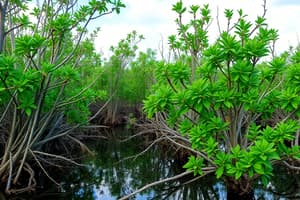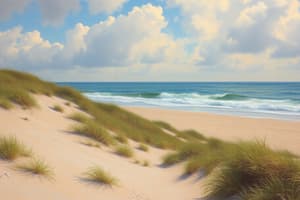Podcast
Questions and Answers
A line of seaweed and litter at the top of the beach is known as a ______ line.
A line of seaweed and litter at the top of the beach is known as a ______ line.
strand
Embryo dunes are very ______ dunes.
Embryo dunes are very ______ dunes.
young
______ grass is a key species in stabilising foredunes.
______ grass is a key species in stabilising foredunes.
marram
Yellow dunes are made of ______ not soil.
Yellow dunes are made of ______ not soil.
A mature dune is considered a ______ community.
A mature dune is considered a ______ community.
When the tide goes out, sand is dried and blown up the ______.
When the tide goes out, sand is dried and blown up the ______.
Sand is transported via aeolian processes such as saltation, suspension, and ______.
Sand is transported via aeolian processes such as saltation, suspension, and ______.
The strand line is a line of seaweed and ______ at the top of the beach.
The strand line is a line of seaweed and ______ at the top of the beach.
The strand line typically has a pH of ______.
The strand line typically has a pH of ______.
Aeolian transport moves sand, forming the ______ line.
Aeolian transport moves sand, forming the ______ line.
Flashcards
Embryo Dune
Embryo Dune
The first stage of dune formation, characterized by small, young dunes formed just above the high water mark. They are easily washed away by tides.
Foredune
Foredune
A type of dune that forms behind embryo dunes and is stabilized by the growth of marram grass. These dunes are more diverse in species, with a covering of various plants.
Yellow Dune
Yellow Dune
A large, yellow dune formed from accumulated sand, reaching heights over 10m. Marram grass dies, forming a thin humus layer which allows other plants to grow.
Mature Dune
Mature Dune
Signup and view all the flashcards
Strand Line
Strand Line
Signup and view all the flashcards
What is a strand line?
What is a strand line?
Signup and view all the flashcards
What is aeolian transport?
What is aeolian transport?
Signup and view all the flashcards
What is saltation?
What is saltation?
Signup and view all the flashcards
What is suspension in aeolian transport?
What is suspension in aeolian transport?
Signup and view all the flashcards
What is creep in aeolian transport?
What is creep in aeolian transport?
Signup and view all the flashcards
Study Notes
Coastal Dune Succession
-
Strand Line:
- Formed at the high tide mark, where dried sand is blown up the beach by wind.
- Composed of seaweed and litter.
- Aeolian transport (saltation, suspension, creep) moves sand to this line.
- pH is 8.5
-
Embryo Dune:
- Small, young dunes.
- Forms above high water mark.
- Sand deposits around obstacles (e.g., rocks, debris).
- Pioneer species (like prickly saltwort and lime grass) colonize, aiding further sand accumulation.
- Fragile, easily washed away by high tides.
- pH is around 8.0 due to shell fragments (CaCO3).
-
Foredune:
- Develops behind embryo dunes.
- Marram grass establishes, stabilizing the dune.
- More diverse plant species colonize, covering the ground.
- pH is around 7.5.
-
Yellow Dune (Semi-fixed):
- Height of 10-20 meters.
- Primarily composed of sand.
- Marram grass dies as the dune grows (above 10m).
- A thin humus layer forms, allowing other plants to grow (more organic matter).
- Partially stable, but not fully fixed.
-
Grey Dune (Fixed):
- No seawater reaches these dunes, making it less salty.
- Richer soil with more humus and organic matter.
- Supports the growth of gorse and heather.
- Known as fixed dunes since the soil is more developed and stable.
- pH is around 7.0
-
Mature Dune (Woodland):
- Climax community, representing the final stage of plant succession.
- Characterized by moist, nutrient-rich soil.
- Supports the growth of woodland species (e.g., pines and birches).
- pH is around 6.0.
Studying That Suits You
Use AI to generate personalized quizzes and flashcards to suit your learning preferences.




